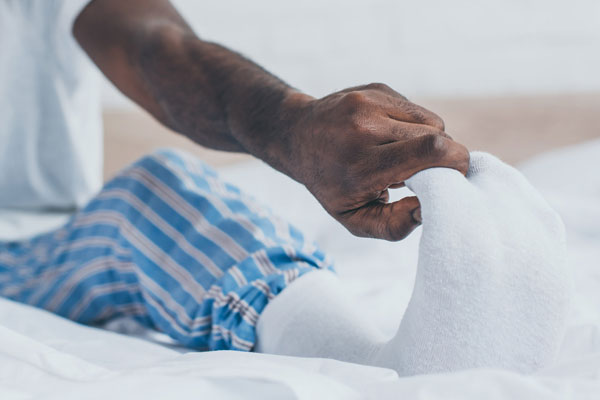Take Control of Chemotherapy-Induced Peripheral Neuropathy
by Cindy Tofthagen, PhD, ARNP, AOCNP, FAANP, FAAN and Constance Visovsky, PhD, RN, ACNP, FAAN
Chemotherapy-induced peripheral neuropathy is a common side effect of cancer treatment. Many standard chemotherapy drugs can cause this type of neuropathy. Symptoms include numbness and tingling that begin in the fingertips or toes and that may move upward into the hands and feet, and then the arms and legs, as the neuropathy worsens. Peripheral neuropathy can also affect your balance and fine motor skills, increasing your risk for falls and making it difficult to carry out certain daily activities, like buttoning a shirt, hitting the right keys on your computer or cellphone, or driving a car. Symptoms may appear shortly after chemotherapy begins but can persist long after treatment is completed.
If neuropathy is affecting your ability to perform normal activities, seek help as soon as possible so you can get your symptoms under control and get back to living your life.
Talk to your doctor if you are experiencing symptoms of peripheral neuropathy. You’ll want to let your doctor know what specific symptoms you’re having and how the symptoms are affecting your daily activities. If you are currently being treated with chemotherapy, your oncologist may need to adjust the dose or try a different chemotherapy drug altogether.
In addition, your doctor may refer you to a neurologist, a doctor who specializes in the treatment of diseases affecting the nervous system. The neurologist may perform tests to identify the extent and type of nerve damage you have and will work with you to develop a plan for managing your neuropathy symptoms.
Your neuropathy management plan should have three main goals:
1. Controlling your pain
Chemotherapy-induced peripheral neuropathy can cause pain or burning sensations in the hands and feet. Controlling neuropathy pain usually requires medications that are different from those used for other types of pain. Two main kinds of drugs are used to treat neuropathy pain: anti-seizure medications and antidepressants. These medicines must be taken on a regular basis, instead of as needed like other pain relievers, and it may take some time before you notice results. Also, not every medicine works for everyone, and different people require different dosages to get pain relief. Your doctor can help figure out what type of medicine and dosage you need to control your neuropathic pain.
2. Keeping you safe
Since neuropathy can affect your balance and make walking more difficult, it’s important that you take steps to prevent falls and injuries to your feet. You should always wear sturdy, well-fitting shoes, preferably ones with a rubber sole – and no flip-flops or sandals that don’t have a heel strap. Wear your shoes even when you’re in your home. To prevent falls in the bath or shower, install a handrail and put down a non-slip mat. When it’s cold out, protect your hands and feet by wearing gloves, warm socks, and thermal footwear.
3. Helping you function better in your daily life
If neuropathy is affecting your ability to perform normal activities, seek help as soon as possible so you can get your symptoms under control and get back to living your life. Several different types of healthcare providers can help you manage your neuropathy symptoms:
A Word of Warning!
Stop. Before you take any vitamins, nutritional supplements, or over-the-counter medications for neuropathy, check with your oncologist or other healthcare provider. Some medications and supplements can interfere with your cancer treatments or may have other potentially harmful effects. Be leery of anyone that tells you they have a “cure” for neuropathy. Numerous unproven treatments are claimed to cure or improve neuropathy; however, these may cost you a lot of money and probably won’t deliver the results they promise.
- A physiatrist (a physician who specializes in cancer rehabilitation) can help get you functioning at your best.
- A physical therapist can help you manage neuropathy by recommending specific exercises to improve your muscle strength and balance. Certain exercise programs, like yoga and tai chi, can also help improve your balance.
- An occupational therapist can work with you to help you maintain your independence, adjust to any physical limitations you may have, and get back to doing your usual activities as quickly as possible.
- A podiatrist can help you take care of your feet, recommend good footwear, and fit you for special inserts that may make walking more comfortable.
- Case managers, registered nurses, and social workers can connect you with resources in your community to meet your specific needs. They can also help you communicate with your healthcare team and your insurance company.
- Support groups and mental health professionals can help you cope emotionally with peripheral neuropathy.
While there is no magic bullet for preventing or treating chemotherapy-induced peripheral neuropathy, there is a good bit you can do to take control of your neuropathy symptoms. You can start by talking to your doctor about your neuropathy, asking for referrals to healthcare providers who can help you manage your symptoms, and then being persistent until you get the help you need.

Dr. Cindy Tofthagen (left) is an associate professor of nursing at the Mayo Clinic College of Medicine and Science, as well as a nurse scientist for the Mayo Clinic, in Jacksonville, FL.

Dr. Constance Visovsky (right) is a professor and the Lewis & Leona Hughes Endowed Chair in Nursing Science at the University of South Florida College of Nursing in Tampa, FL.
The Foundation for Peripheral Neuropathy is a nonprofit organization that helps people with any form of neuropathy. Visit FoundationForPN.org to learn more about chemotherapy-induced peripheral neuropathy and to find neuropathy support groups in your area.
This article was published in Coping® with Cancer magazine, November/December 2021.


